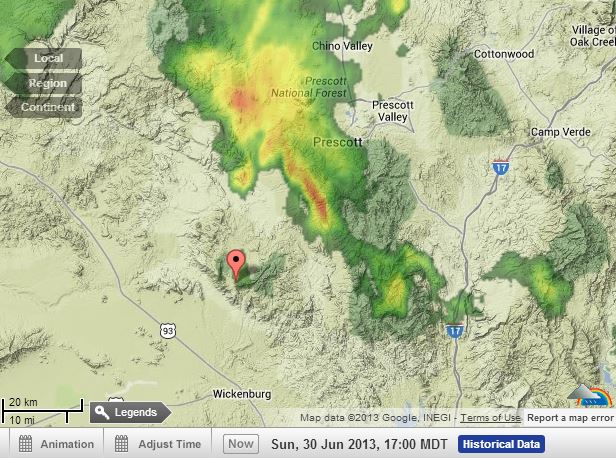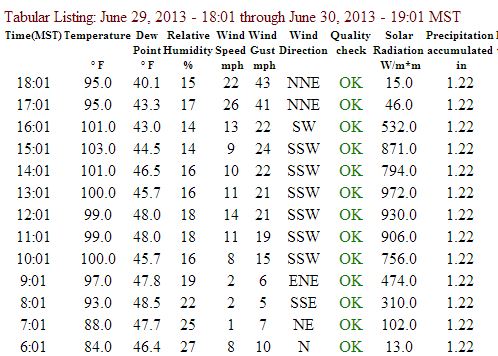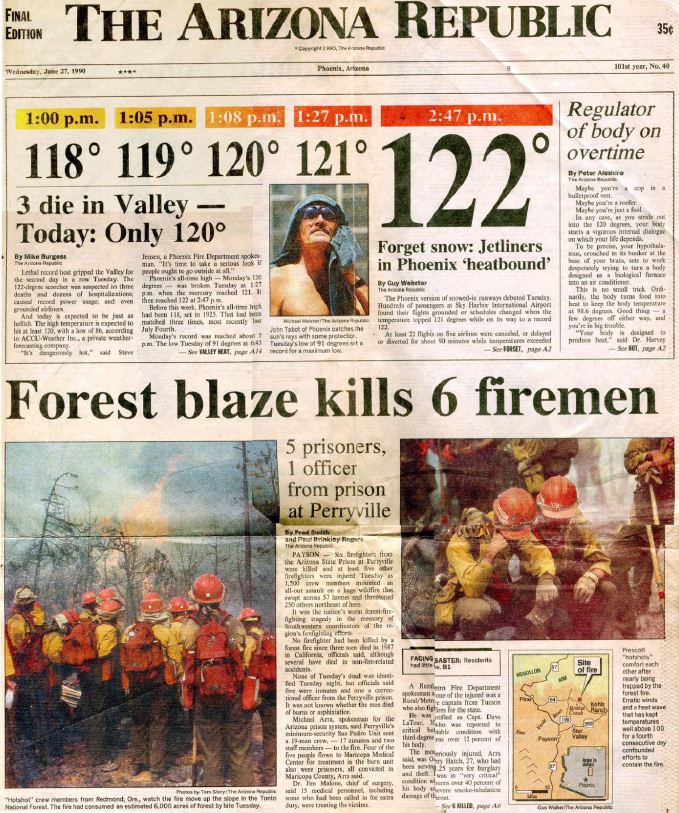We first wrote about the thunderstorm that may have contributed to the June 30 deaths of the 19 firefighters on the Yarnell Hill Fire, June 30 at 6:58 MST. But since that information is buried in a long article about the fire, and a little more information has emerged, we are summarizing the facts about the weather conditions that tragic Sunday afternoon. We also have some suggestions for providing firefighters with weather warning information that could save lives.
The formal investigation into the deaths, what caused them and any lessons to be learned, is just beginning. The results will probably not be known for many months. We will leave it up to the investigators to determine why it happened and what decisions were made before and during the incident. But the facts about the weather that day have already been recorded in various ways.
Carrie Dennett, a Fire Information Officer with the Arizona State Forestry Division, said the Arizona Dispatch Center received a call at 4:47 p.m. MST, June 30, that firefighters on the Yarnell Hill Fire had deployed fire shelters. The Dispatch Center was not in direct communication with firefighters on the ground at the fire. The information would typically have been relayed from the local Yarnell Hill Fire organization up through lower level dispatch offices.

The radar map above from WeatherUnderground at 4 p.m. MST June 30 shows a large thunderstorm cell north and northeast of the fire at Yarnell, Arizona. The pointer is at Yarnell. At 10:55 a.m., according to data from the MODIS satellite, the fire was approximately a mile or so north and northeast of the town, between the town and the approaching thunderstorm. At that time and until after 4 p.m., the wind blowing from the south-southwest and the southwest, most likely would have caused the primary spread of the fire to be toward the northeast.
Animations of weather satellite images that afternoon HERE and HERE, show the development and movement of the thunderstorm into the fire area. The red “X” and circle mark the approximate location of the fire.
Before and after 4 p.m. the cell was moving toward the southwest, and may have produced strong winds that changed the wind direction by 180 degrees (see below) and may have been the reason the fire moved into Yarnell. It also could have caught firefighters by surprise.
From 10 a.m. until 4 p.m. local time at the Stanton RAWS weather station four miles south of the fire, the wind was from the south-southwest or southwest, but between 4:01 p.m. and 5:01 p.m. it began blowing from the north-northeast at 22 to 26 mph gusting up to 43 mph — a 180-degree change in the wind direction.

We were told by a spokesperson for the fire that the location of the firefighters when they died was between the fire and Yarnell, which would put them north or northeast of the town. Michelle Lee of the Arizona Republic told us that they were about one quarter mile southwest of Glen Ilah estates, “in the mountains”. Glen Ilah is on the southwest side of Yarnell. Anyone in that area between 4 and 5 p.m., who previously had the wind at their backs for seven hours with the fire moving away from them, may have suddenly and unexpectedly found the fire heading toward them at a rapid rate, pushed by winds gusting over 40 mph. Wind direction changes like this can be caused by strong outflowing winds from a thunderstorm in the dissipating stage.
At 5:01 p.m. the temperature was 95 degrees and the relative humidity was 17 percent. That, coupled with sustained winds of 26 mph with gusts over 40 mph, could have caused the rate of spread to increase to the point where it would have been impossible for any firefighting resources, in the air or on the ground, to implement any kind of effective fire suppression action, especially at the head of the fire which was moving rapidly toward Yarnell.
The Weather Forecast
A Type 3 Incident Management Team transitioned to assume command of the fire at 10 a.m. on June 30. That morning the fire had burned less than 1,000 acres. Incident Meteorologists from the National Weather Service, IMETs, are frequently assigned to large wildfires. While they are on site they can provide a great deal of very detailed weather information to firefighters, monitoring the conditions closely and in constant communication with the IMTeam.
It would have been unusual for an IMET to be assigned to a fire of that size on June 30, and with a small Type 3 IMTeam. The next morning, however, an IMET did receive an order to respond to the fire along with a much larger Type 1 IMTeam.
But even without an on-scene IMET, firefighters have the capability to request from the National Weather Service a special “spot forecast” for a fire, and at least two were provided before the fatalities occurred, one at 8:33 p.m. MST on June 29, and another at 9:45 a.m. June 30. The latter one, according to the information at the top of the forecast, was requested at 9:39 a.m. MST and produced six minutes later, a remarkably short turnaround.
The spot forecast for the morning of the incident predicted “isolated thunderstorm activity”, and, “Partly cloudy. A slight chance of showers and thunderstorms in the afternoon”. The predicted wind was “east winds around 5 mph…becoming southwest with gusts up to 20 mph in the afternoon”.
It is extremely difficult or even impossible for meteorologists to predict exactly where and when thunderstorms will occur, especially if they are “isolated”, or few in number. It is also difficult to forecast the exact wind speed and direction under any conditions.
Where do we go from here?
Firefighters need to know when there is a sudden change in weather conditions that can threaten their safety. Since it will never be possible to have an IMET at every fire, there needs to be a concerted interagency effort involving the National Weather Service and the *land management agencies, state, local, and federal, to develop a system to provide firefighters with the situational awareness information they must have to reduce the probability that they will be surprised by a life-threatening change in the weather.
Firefighter’s Emergency Situational Awareness Device — FESAD
We may need new developments in hardware for firefighters so that they can receive weather warning data directly from the source without going through layers of bureaucracy. The military probably already has something like this, but I envision a device with a 7-inch display that could receive satellite transmissions anywhere there is a clear view of the sky. Each firefighter would not need to have a Firefighter’s Emergency Situational Awareness Device, a FESAD — just provide one for every fire. It could be based on a satellite phone, would have a GPS receiver (like in most smart phones), and be capable of receiving text and images. A deluxe version might also function as a satellite telephone, so that the firefighter could call the weather forecaster to get more information. The person sending the data to the fire would not have to know the phone number of the receiver, but would draw a box on a map and any devices within that box would receive the data, without bothering others that would not be affected by the warning. When the FESAD arrives at a fire, the user could have it send a message registering its location so that warnings for that area could be received. This would also alert the on-duty Remote-IMET to add it to their watch list.
Alert who?
Remote-IMET (R-IMET)
The warning data could be sent to the fire by an NWS forecaster always on duty with the primary responsibility to remotely monitor weather conditions near multiple fires. (The NWS already does this for the entire nation for severe storm, tornado, and hurricane warnings.) For fires, let’s call them Remote-IMETS. Some of the Geographic Area Coordination Centers already employ full time fire meteorologists. With the right software they could perform this function.
An R-IMET would have the technology available to instantly transmit text and graphical data about an emerging dangerous condition directly to those on the ground without relying on telephones to filter the information down through various layers. An R-IMET would not have time to handle all of the IMET duties normally performed by an on-scene IMET, but would concentrate primarily on issuing urgent warnings that could affect the safety of firefighters.
What if …. there had been a FESAD and R-IMET available for the Yarnell Hill Fire
FESADs and R-IMETs could save lives.
The iron is hot
There is a great deal of national interest right now in the deaths of the Granite Mountain 19. If any new initiatives that would cost money are going to be implemented, our Fire Leaders must strike now while the iron is hot. There may be a small window of two to four weeks during which there will be some sympathy nationwide and citizens and lawmakers are open to enhancing the safety of wildland firefighters, even if it involves spending money.
An example of a rapidly closing window of opportunity is the movement for controlling gun violence after a gunman fatally shot twenty children and six adult staff members at Sandy Hook Elementary School in Newtown, Connecticut. If the administration and lawmakers had taken action quickly, meaningful legislation would have had a much better chance of passing. Instead, they waited months, and achieved little.
*A side note
It pains me to describe the federal fire departments as “land management agencies”. Organizations whose primary mission is to grow trees, clean campground toilets, or manage visitors, do not have at the top of their To-Do List, “Provide real-time weather warning information for firefighters”. We need a National Fire Service.





